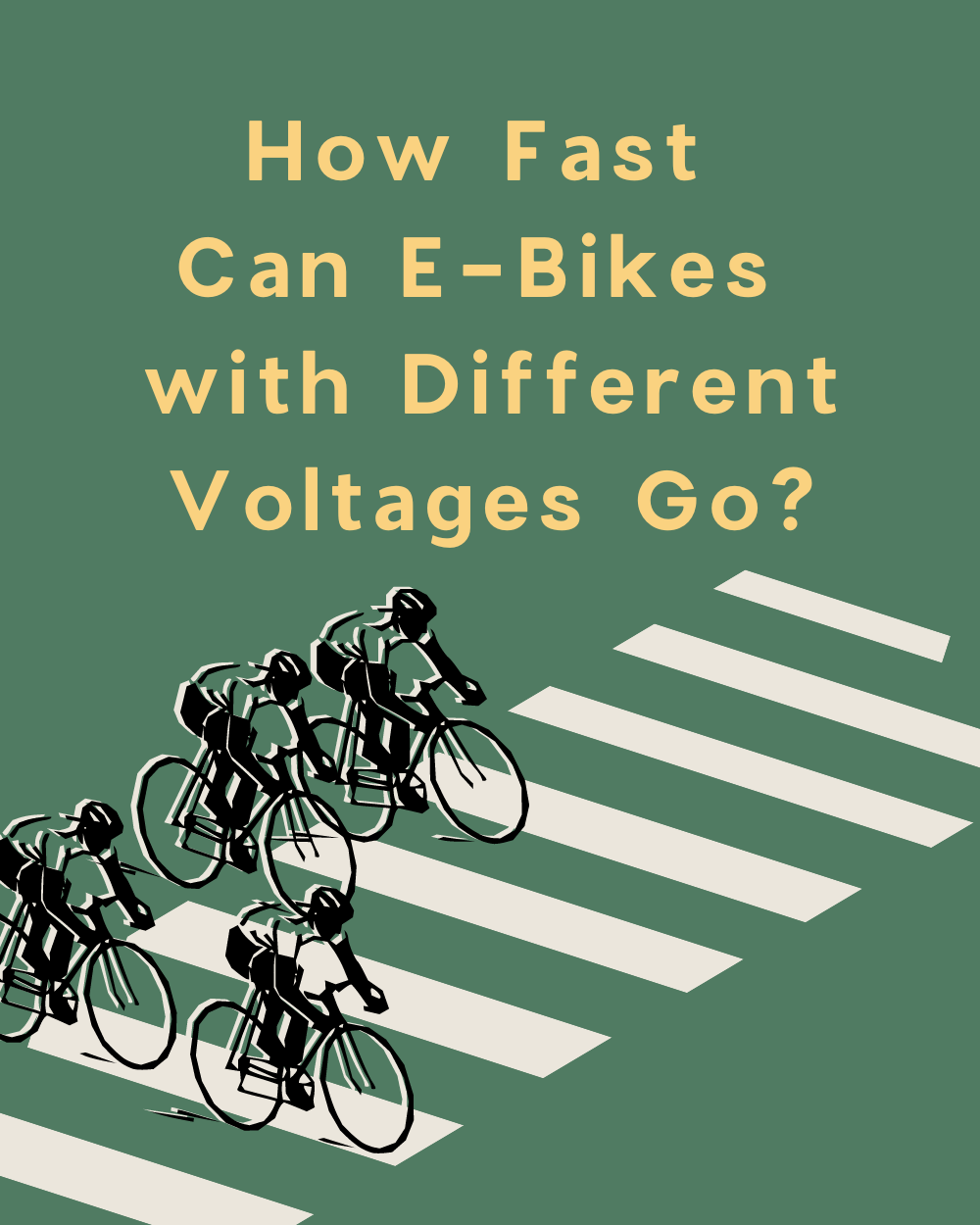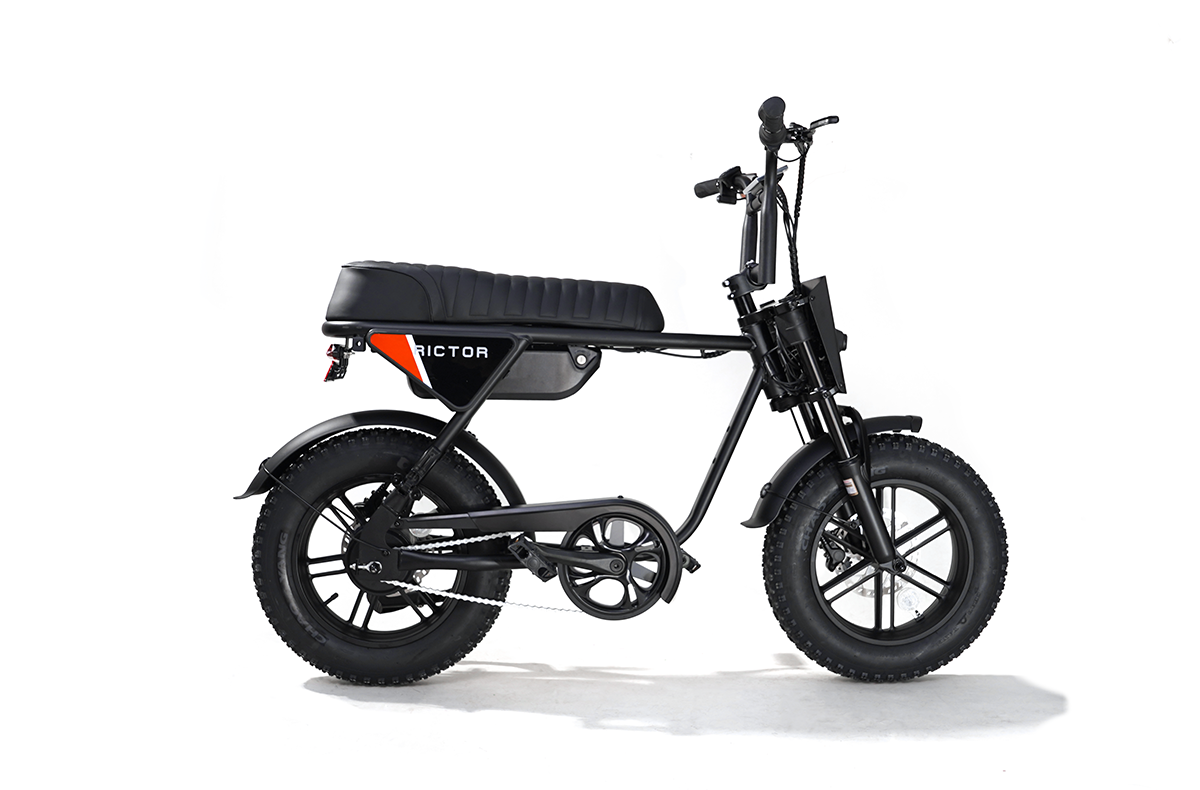
How Fast Can E-Bikes with Different Voltages Go?
Battery voltage is a key factor that directly influences an electric bike’s performance, including acceleration, torque, and top speed.
A higher voltage often means more power, allowing the motor to operate at its full potential and providing a more dynamic riding experience.
In this article, you'll also gain insights into how voltage impacts your e-bike's range.
Voltage and E-Bike Speed
Voltage is measured in volts (V) and is a key indicator of the potential power available in an e-bike’s battery. It is part of the electrical system that includes the battery, motor, and controller. we’re referring to the amount of electrical energy that the battery can deliver to the motor. Higher voltage allows for more power to be transferred to the motor, which can result in better performance in terms of speed and acceleration.
More detail!
Higher voltage batteries can deliver more power to the motor. For instance, a 48V battery can deliver more power than a 36V battery, which usually results in a higher top speed.
How to calculate the Ebike's power?
P=V×I
Where:- P is the power in watts (W)
- V is the voltage in volts (V)
- I is the current in amperes (A)
48V battery can deliver more power than a 36V battery if the current remains constant. This increased power generally translates to a higher top speed and better acceleration. However, the exact speed gain depends on how efficiently the motor can convert this electrical power into mechanical power.
To illustrate, let’s assume you have an e-bike with a 36V battery delivering 10A of current:
P=36V×10A=360W
Now, if you upgrade to a 48V battery with the same 10A current:
P=48V×10A=480W
The power output increases by 120W simply by upgrading the voltage, which could significantly enhance the e-bike’s speed and performance, assuming the motor and other components can handle the additional power.
Current Flow
Voltage also directly affects the current flow, or amperage, in the e-bike’s electrical system.
Current (I) is the flow of electric charge, and it plays a crucial role in determining the torque and overall performance of the motor.
When you increase the voltage, the motor can draw more current, which increases the torque — the force that helps the e-bike start moving and climb hills.
The relationship between heat, current, and voltage is governed by Ohm’s Law, which states:
V=I×R
Where:
- V is the voltage
- I is the current
- R is the resistance in the circuit
Higher current flowing through the motor’s windings generates more heat due to the resistance (R) within the motor’s coils.
Don’t worry about this heat. The e-bike battery won’t keep heating up constantly.
The BMS is responsible for monitoring and controlling the flow of electricity between the battery and the motor. It regulates the current to prevent excessive heat buildup and ensures that the battery operates within safe parameters.
SEE ALSO The RICTOR K1 is the BEST ALL AROUND EBike Under $2,500!
Different Voltages
36V E-Bikes
36V batteries are pretty standard in entry-level e-bikes.
They give you enough power to handle your everyday activities like running errands or going shopping.
These bikes usually top out around 15-20 mph, which is just fine for getting around town where you don’t need a ton of speed.
Depending on the battery’s size, you can expect to get around 20-40 miles per charge, which should cover most of your daily trips.
However, 36V bikes might struggle when it comes to steeper hills or carrying heavier loads.
They don’t accelerate as quickly, and they’re not as capable in tougher riding conditions compared to bikes with higher voltage systems.
48V E-Bikes
48V batteries are more common in mid-range to higher-end e-bikes and offer a solid mix of speed, power, and efficiency.
With a 48V e-bike, you’re looking at speeds of 20-28 mph, depending on your motor and controller setup.
This makes them a great choice if your daily ride involves a few hills or longer distances, like commuting to work.
These bikes also tend to have a range of 30-60 miles per charge, so they’re perfect for longer rides or weekend adventures.
The 48V system gives you better acceleration and is much better at climbing hills compared to the 36V models.
If you’ve got a commute that includes some tough terrain, a 48V bike is a solid option that can handle more weight and rougher conditions.
52V E-Bikes
52V batteries are usually found in high-performance e-bikes and are for those who want the best in speed and power.
These bikes can easily hit speeds over 28 mph, with some models even pushing 35 mph or more.
That’s great if you’re into off-road adventures or long-distance touring.
Depending on the battery, you could get 40-80 miles on a single charge. The higher voltage also makes these bikes more efficient, potentially giving you more range than lower voltage systems.
A 52V bike has the most torque, which makes it awesome for handling steep hills, heavy loads, and rough terrain.
The acceleration is faster, and the overall ride feels more powerful and responsive, making these bikes a top pick for those who want serious performance.
Does Voltage Increase Speed
Motor Design and Capability
Motors are built to work within specific voltage ranges.
If you start pushing more voltage than your motor is designed for, you could end up with a motor that overheats, loses efficiency, or even breaks down altogether.
So, if you’re thinking about upgrading your battery for more speed, make sure your motor can handle it; otherwise, you might find yourself stuck on the side of the road with a fried motor instead of zipping along at high speed.
Controller Efficiency
The controller is kind of like the brains of your e-bike’s electrical system.
It decides how much power gets sent from the battery to the motor based on what you’re doing—whether you’re gently cruising or gunning it up a hill.
If your controller isn’t built to handle higher voltage, it could choke your motor’s performance or, in the worst-case scenario, cause your whole system to glitch out.
When upgrading your battery for more power but not getting the speed boost you expected because your controller just can’t keep up.
That’s why it’s crucial to upgrade your controller along with your battery if you’re going for a voltage increase.
Battery Capacity and Range
When you increase the voltage, you’re also asking for more juice from your battery, which can drain it faster.
Think of it like driving a car at higher speeds—it burns through fuel quicker. The same goes for your e-bike’s battery.
Higher voltage systems usually need batteries with a bigger capacity, meaning more amp-hours, to keep you from running out of power halfway through your ride.
But here’s the trade-off: bigger capacity batteries are heavier and more expensive.
So, if you’re planning on long rides, you’ll need to balance the extra power you want with the added weight and cost of a larger battery.
Environmental Factors
Let’s talk about where you’re actually riding. If you’re cruising through city streets with lots of traffic, pedestrians, and stoplights, higher speeds might not always be your friend.
Going faster means you need better brakes and sturdier tires to stay safe, especially when you’re dodging cars or weaving through tight spots.
On the other hand, if you’re hitting off-road trails, that extra speed and power from a higher voltage can be a blast, helping you tackle steep hills and rough terrain.
But remember, the extra strain on your bike’s components from higher speeds means you’ll need to keep an eye on maintenance to avoid any nasty surprises.
Is Higher Voltage Always Better
Cost Implications
Higher voltage e-bikes generally come with a heftier price tag. The cost of the entire bike—including the battery, motor, and controller—tends to increase with voltage.
In today’s e-bike market, a basic 36V e-bike might cost you around $1,000 to $1,500, depending on the brand and features.
However, if you’re looking at a 48V e-bike, you can expect to pay about $300 to $500 more for similar models, bringing the total to $1,500 to $2,000.
52V e-bike's price could jump even higher, often starting around $2,000 and going up to $3,000 or more, depending on the brand and quality.
This price difference can be significant, especially for riders on a budget.
For many, a 36V or 48V e-bike provides a better balance between performance and cost, making them more accessible without sacrificing too much in terms of power and range.
Weight Considerations
Higher voltage batteries tend to be larger and heavier, which can affect the bike’s handling and portability.
Upgrading from a 36V to a 48V battery could add an extra 2 to 5 pounds to your bike’s weight.
A 52V battery might add even more, potentially increasing the weight by 5 to 10 pounds compared to a 36V setup.
This added weight can make the bike harder to maneuver, especially if you need to carry it up stairs or onto public transportation.
It’s not just about lifting the bike—riding with a heavier battery can also change how the bike feels, making it less nimble and more challenging to handle, especially in tight spaces or during quick turns.
Compatibility and Upgradability
When it comes to upgrading an existing e-bike to a higher voltage, compatibility is key.
Not all e-bike components are designed to handle higher voltages, and if you’re thinking about making the switch, you need to ensure that your motor and controller are up to the task.
If your bike currently runs on a 36V system and you’re looking to upgrade to 48V or 52V, you might also need to upgrade the controller to avoid potential issues like overheating or reduced efficiency.
This process can be complex and costly, particularly for those who aren’t familiar with the intricacies of e-bike electronics.
For riders who are comfortable with DIY upgrades and have a good understanding of their bike’s components, upgrading to a higher voltage system can be a rewarding way to boost performance.
Just be prepared for the additional cost and effort involved.
Legal and Safety Concerns
In many regions, e-bikes are subject to speed regulations.
For example, in the United States, e-bikes are often limited to a maximum speed of 20 mph when operating on public roads.
Exceeding this speed could classify the e-bike as a motor vehicle, requiring registration, insurance, and a special license.
Additionally, higher speeds increase the risk of accidents, and riders should always wear appropriate safety gear.
Conclusion
Choosing between a 36V, 48V, or even a 52V e-bike ultimately depends on your specific needs and riding habits.
If you're looking for an economical option for daily commutes and lighter tasks, a 36V e-bike will suffice.
However, if you need more power for hilly terrains or longer distances, a 48V system offers a great balance between performance and cost.
For those seeking maximum speed and torque, particularly for off-road adventures or carrying heavier loads, a 52V e-bike is the way to go.
Ultimately, the right voltage depends on what you value most in your riding experience.
FAQs
How long does an e-bike battery typically last before it needs to be replaced?
On average, an e-bike battery can last between 3 to 5 years, depending on usage, maintenance, and the quality of the battery. Regular charging cycles and proper storage play crucial roles in extending the battery's lifespan.
Can I charge my e-bike battery with a solar panel?
Yes, you can charge your e-bike battery using a solar panel, provided the panel and charger are compatible with the battery's voltage and current requirements. This eco-friendly option is popular among e-bike users who enjoy long trips or off-grid adventures.
What factors can cause an e-bike battery to degrade faster?
Extreme temperatures, frequent deep discharges, and improper storage can all contribute to faster degradation of an e-bike battery. It's important to store your battery in a cool, dry place and avoid letting it completely drain too often.
💡 Explore More Here!
- Is Riding an E-bike Cheating? Or Is It the Ultimate Hack?
- Riding in Wet Weather? Be careful, it can damage your bike!
- How Much Does an Electric Bike Cost? Build Your Own or Buy New?
- Are Electric Bikes Allowed in National Forests? (In Some, Yes)
- Should You Buy Ebike from Amazon? Not a Bad Idea, But I Will Choose RICTOR!



